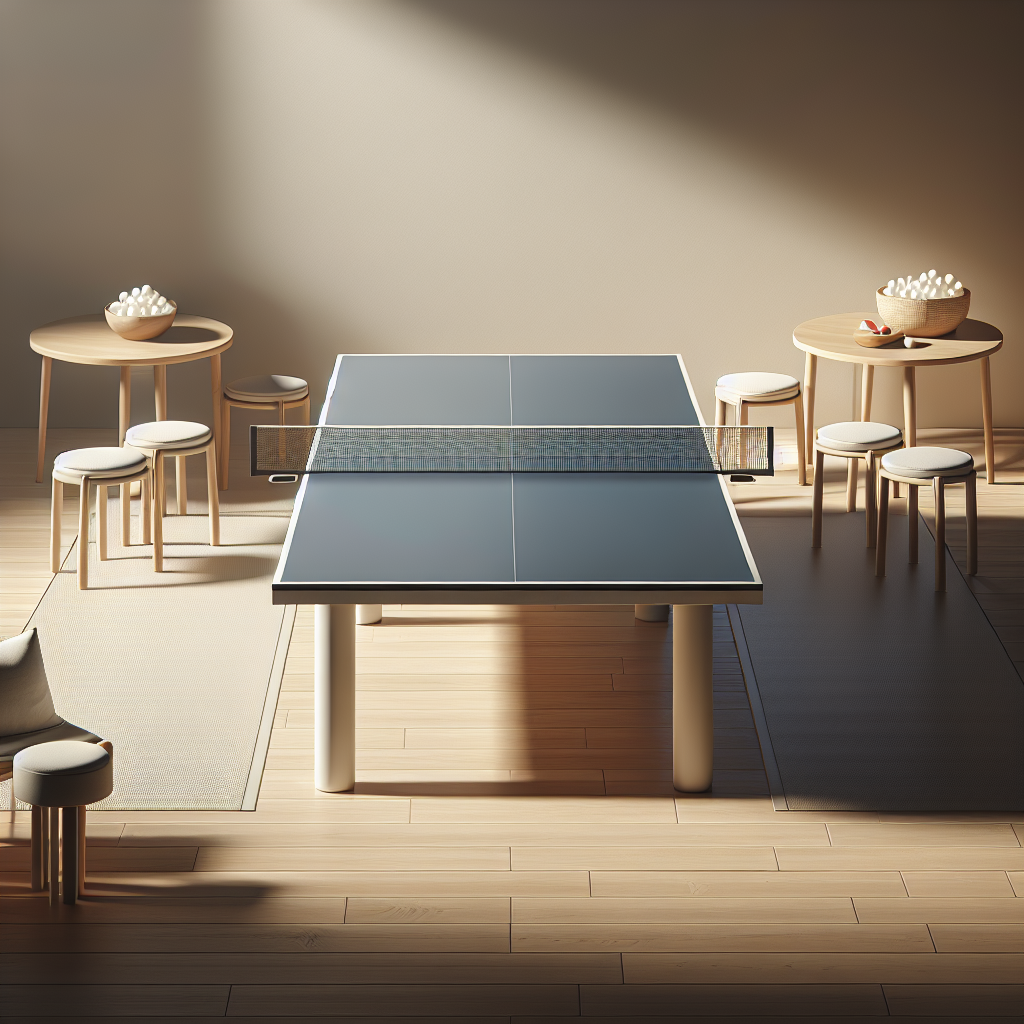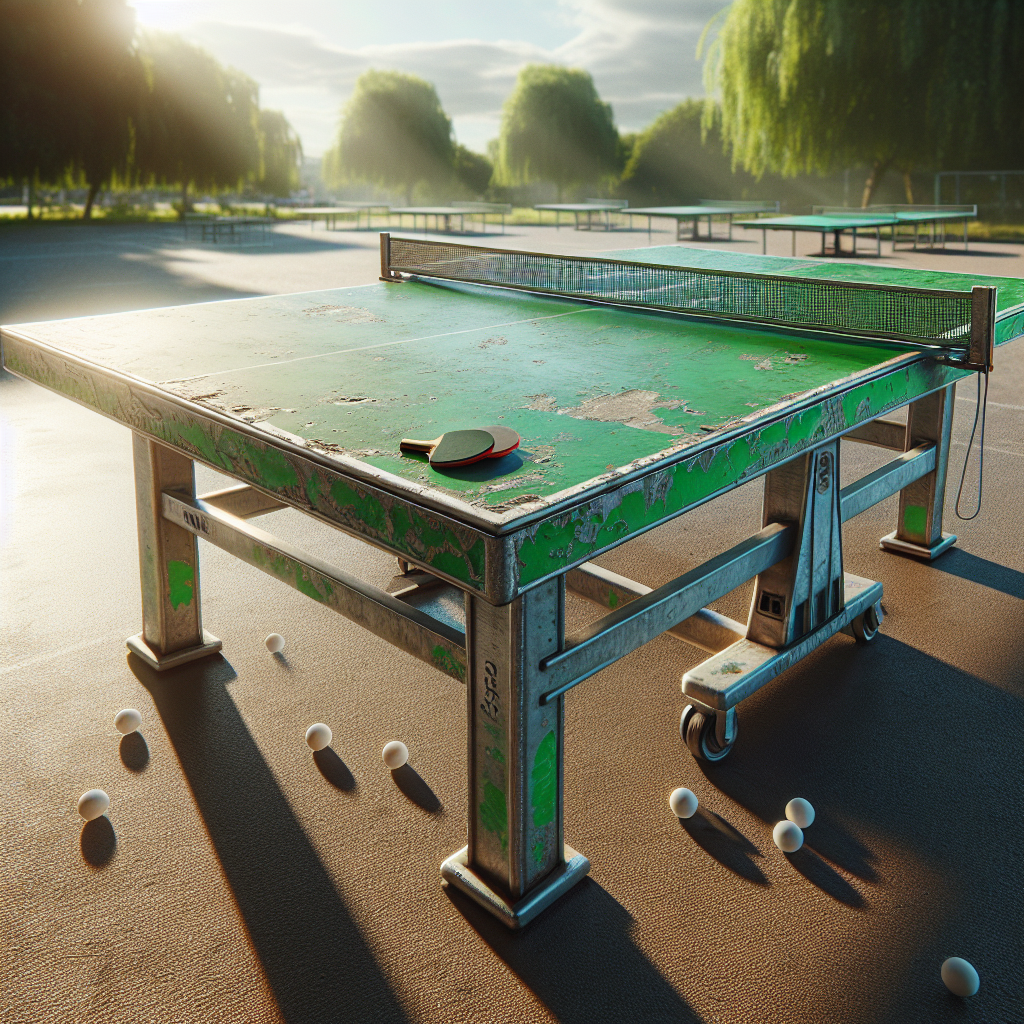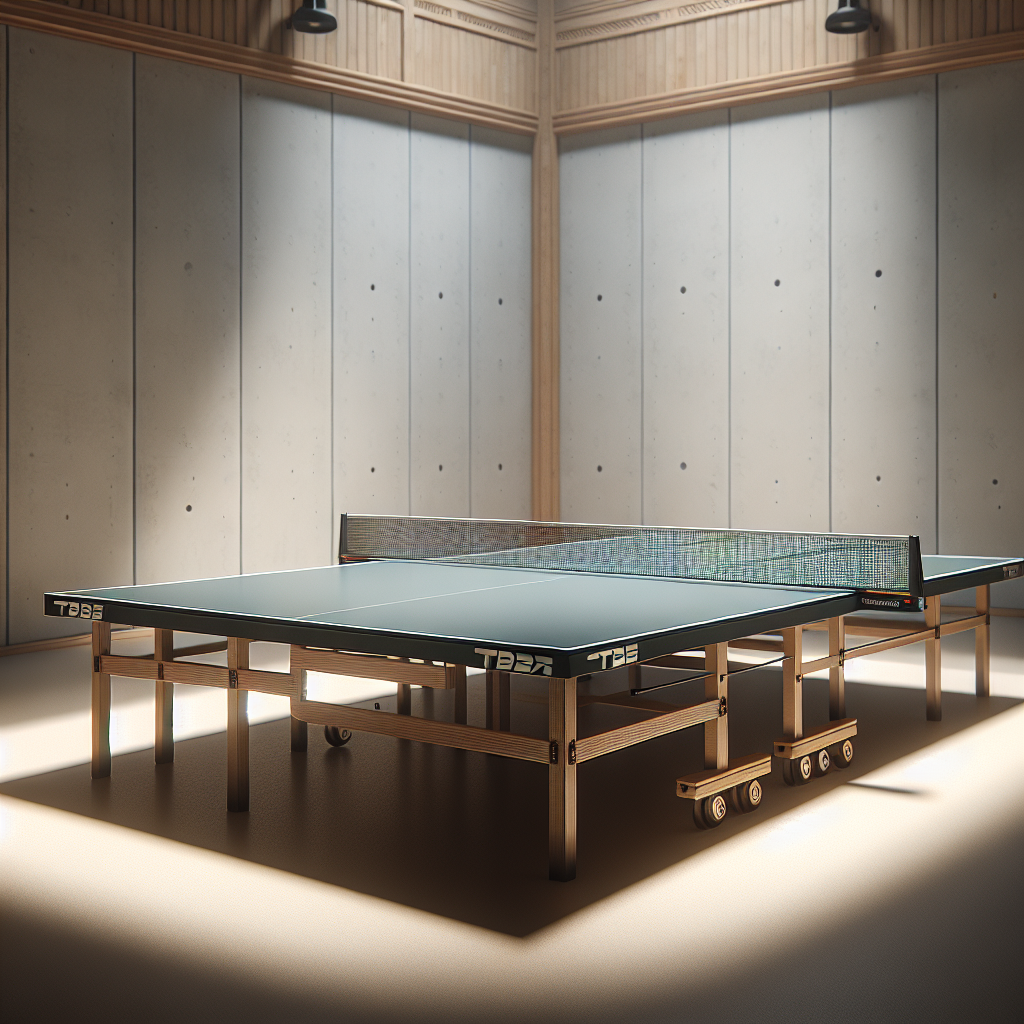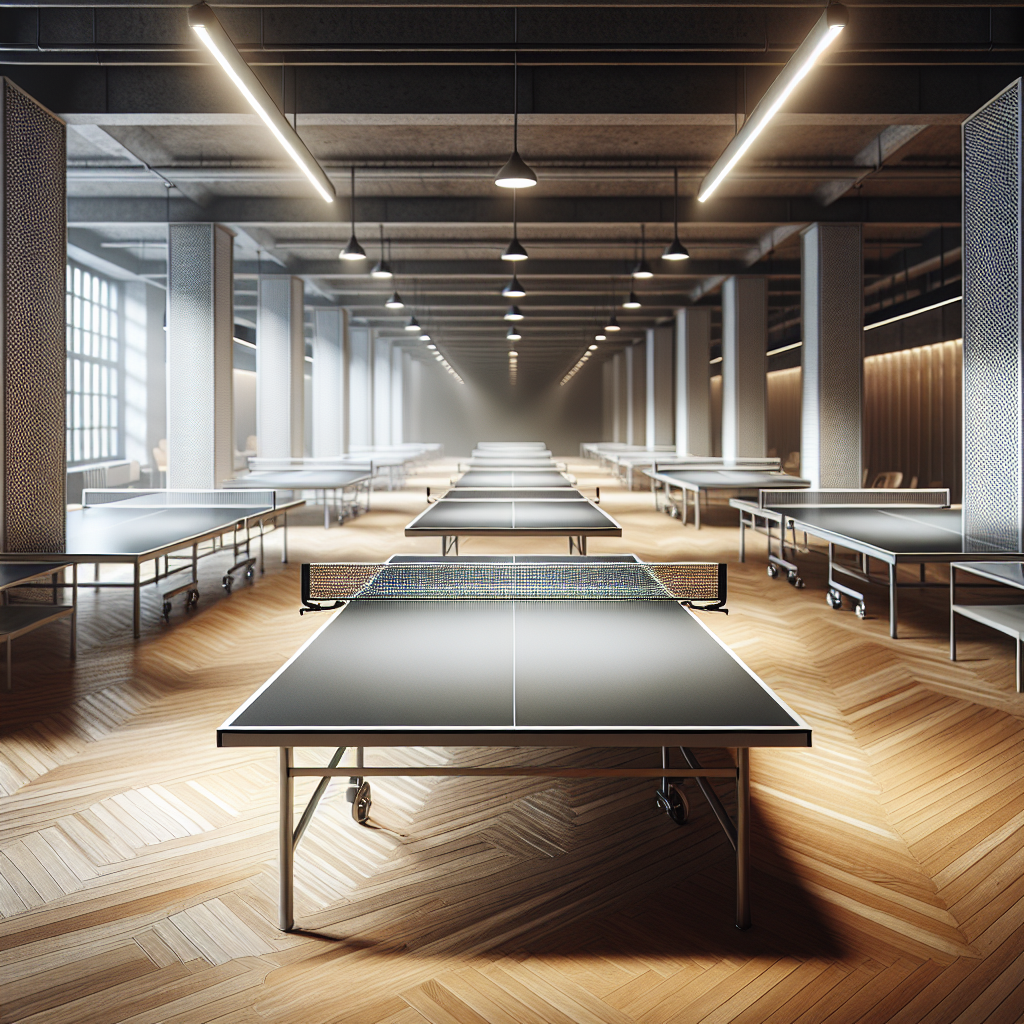Ping Pong Table Dimensions
When it comes to ping pong tables, understanding the dimensions is essential for both recreational and professional players. The standard ping pong table size, as well as the regulation thickness requirements, play a significant role in the game.
Standard Ping Pong Table Size
A standard ping pong table measures 9 feet long, 5 feet wide, and 2.5 feet high. The table is divided into two equal halves by a net that is 6 inches high. The playing surface of the average table is made of a continuous piece of material, typically green or blue, and has a thickness between 0.5 – 1 inch.
| Dimension | Measurement |
|---|---|
| Length | 9 feet |
| Width | 5 feet |
| Height | 2.5 feet |
| Net Height | 6 inches |
Regulation Thickness Requirements
Ping pong tables are available in various thicknesses, typically ranging from 12mm to 25mm. The International Table Tennis Federation (ITTF) sets regulations for table thickness in sanctioned competitions. According to the ITTF, the minimum thickness required for official competitions is 22mm (STIGA).
Thicker tables (20-25mm) provide a more consistent and higher ball bounce, allowing players to execute spin shots and more intricate techniques. The increased thickness also enhances the overall stability and durability of the table, ensuring a level playing surface and resistance to warping or sagging over time.
| Thickness | Description |
|---|---|
| 12 – 19mm | Thinner tables suitable for recreational play or practice sessions |
| 20 – 25mm | Thicker tables preferred by professional or advanced players for better ball bounce and control |
It’s important to note that while thicker tables are generally favored by professional or advanced players, intermediate and recreational players may find thinner tables more suitable for casual play or practice sessions (STIGA). The choice of table thickness ultimately depends on individual preferences and the level of play.
Understanding the standard ping pong table size and the regulation thickness requirements provides players with the necessary information to select the right table for their needs. Whether you’re a recreational player looking for a table for fun family games or an advanced player seeking the best playing experience, considering these dimensions is crucial to ensure an optimal ping pong experience.
Importance of Table Thickness
When it comes to ping pong tables, the thickness of the table top plays a crucial role in the game. The thickness of a ping pong table typically ranges from 12mm to 25mm. Let’s explore the importance of table thickness in terms of its impact on ball bounce and its durability and longevity.
Impact on Ball Bounce
Thicker ping pong tables, typically ranging from 20mm to 25mm, offer a more consistent and higher ball bounce. The added thickness allows the ball to rebound off the table with greater energy, enabling players to execute spin shots and more intricate techniques. The increased ball bounce on thicker tables enhances the overall gameplay experience, allowing for more dynamic and exciting rallies.
The additional thickness of the table top also absorbs less energy from the ball, resulting in a faster game pace. This can be particularly advantageous for players who prefer a more aggressive playing style. With a faster ball speed, players can strategically plan and execute their shots, keeping their opponents on their toes.
Durability and Longevity
Thicker ping pong tables tend to be more robust and resistant to warping or sagging over time, ensuring a level playing surface. This stability becomes crucial during intense rallies and powerful shots, as the table needs to withstand the impact without significant vibrations or movement. Thicker tables provide a solid and reliable surface, allowing players to focus on their game without any distractions.
In addition to enhanced stability, thicker ping pong tables often boast improved durability and longevity compared to thinner tables. The additional thickness adds structural integrity, making the table more resistant to wear and tear, chipping, cracking, or warping. Investing in a thicker table ensures that your ping pong table will remain in excellent condition, providing countless hours of gameplay for years to come.
Professional or advanced players generally prefer thicker ping pong tables as they offer a higher level of control, faster gameplay, and better ball bounce. Intermediate and recreational players may find thinner tables more suitable for casual play or practice sessions. It’s important to consider your skill level and playing style when choosing the table thickness that best suits your needs.
To ensure the highest quality and performance, it is recommended to invest in ping pong tables with a robust table top and undercarriage. Stronger undercarriages are especially important for tables intended for use in schools or public spaces that will endure wear and tear. Tables like the Elite Roller CSS with a 25mm-thick table top or the Elite Roller Advance with a 22mm-thick table top provide the durability and stability required for intense gameplay.
In conclusion, the thickness of a ping pong table has a significant impact on the game. Thicker tables offer improved ball bounce, durability, and longevity, making them a preferred choice for professional and advanced players. However, the thickness of the table should be chosen based on individual preferences and playing styles. By selecting the right table thickness, you can enhance your ping pong experience and enjoy the game to its fullest.
Choosing the Right Table
When it comes to selecting a ping pong table, it’s essential to consider the specific needs and skill level of the players. Whether you’re an advanced player or someone who enjoys ping pong recreationally, different factors come into play to ensure an optimal playing experience.
Considerations for Advanced Players
Professional or advanced players generally prefer thicker ping pong tables as they offer a higher level of control, faster gameplay, and better ball bounce (STIGA). Thicker tables, typically ranging from 20-25mm, provide a truer bounce, allowing for precise shots and strategic play. The added thickness of the table top contributes to improved ball response and reduced vibrations.
Additionally, thicker ping pong tables often boast improved durability and longevity compared to thinner tables. The additional thickness adds structural integrity, making the table more resistant to wear and tear, chipping, cracking, or warping, ensuring that your investment will last for years to come (STIGA).
To cater to the needs of advanced players, there are various best ping pong tables available on the market. These tables offer superior craftsmanship, advanced features, and precise engineering to meet the demands of competitive play. Investing in a high-quality table with a thicker surface and sturdy undercarriage is crucial for advanced players seeking a professional-level playing experience.
Options for Recreational Players
Intermediate and recreational players may find thinner ping pong tables more suitable for casual play or practice sessions. Tables with a thickness ranging from 12-15mm can still provide an enjoyable playing experience while being more budget-friendly. These tables offer sufficient bounce and stability for recreational play and are ideal for family game nights or friendly matches with friends.
If you fall into the recreational player category, there are various ping pong tables for sale that cater to your needs. These tables offer a balance between affordability and quality, providing a solid playing surface and reasonable durability for regular use.
When choosing a ping pong table, it’s also important to consider other factors such as table size, portability, and storage options. Recreational players may prefer mini ping pong tables or foldable options that can be easily set up and stored when not in use. These tables offer convenience and flexibility for those who have limited space or want to take their game on the go.
By considering the specific requirements of advanced players and recreational players, you can make an informed decision when selecting a ping pong table. Whether you opt for a thicker table to enhance your professional-level skills or choose a thinner table for casual play, finding the right table will contribute to an enjoyable and satisfying ping pong experience.
Specialized Ping Pong Tables
When it comes to ping pong tables, there are specialized options available to cater to different needs and environments. In this section, we will explore two types of specialized ping pong tables: outdoor tables and foldable and compact options.
Outdoor Tables
For those who enjoy playing ping pong in outdoor environments, outdoor tables are specifically designed to withstand various weather conditions. These tables are built to endure elements such as frost, UV radiation, temperature fluctuations, heat, and moisture. They often feature surfaces made of materials like aluminum or fiberglass, which provide durability and resistance to outdoor conditions.
Industrial outdoor ping pong tables with steel undercarriages and metal nets are particularly robust and can last for over a decade in different weather conditions. These tables are suitable for schools, leisure centers, workplaces, or other public spaces where they may be exposed to heavy use and constant exposure to the elements (STIGA Sports).
When selecting an outdoor ping pong table, consider factors such as weather resistance, sturdiness, and the ability to attach the table to the ground for added stability. These tables provide an excellent opportunity to enjoy the game of ping pong in outdoor settings without worrying about weather-related wear and tear.
Foldable and Compact Options
Foldable and compact ping pong tables are designed to offer convenience and versatility. These tables come in various forms, such as 1-piece centerfold tables and 2-piece foldable tables. The 2-piece foldable tables are lighter and easier to move, making them a popular choice among recreational players. They also offer the added benefit of solo playback mode, allowing individuals to practice their skills by folding up one side of the table for an angled rebound.
Mini ping pong tables are another type of foldable and compact option. These tables are approximately the size of a small home office desk, making them perfect for small spaces like living rooms, children’s rooms, or home offices. They can be folded up and easily stored behind a door or under a bed when not in use. With their compact size and portability, mini tables offer a convenient way to enjoy a game of ping pong without requiring a dedicated play area (STIGA Sports).
In addition to mini tables, there are also midi tables available. These tables are slightly larger than mini tables, with dimensions similar to a regular dining table. Midi tables offer a larger playing surface and can serve multiple purposes when not in use, such as assembling jigsaw puzzles. They are easy to fold up and store due to their 6 cm thickness when folded.
Foldable and compact ping pong tables provide flexibility and convenience, making them ideal choices for recreational players and those with limited space. Whether you opt for a mini table for small spaces or a midi table that can serve dual purposes, these options allow you to enjoy the game of ping pong without compromising on space or portability.








